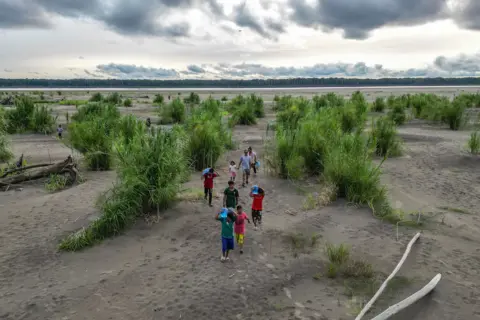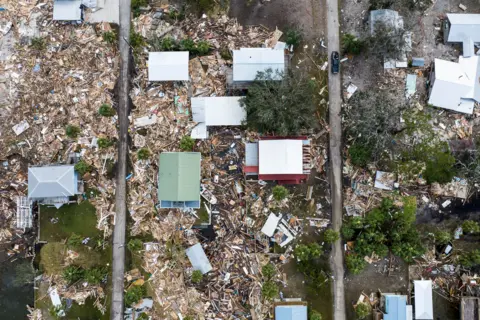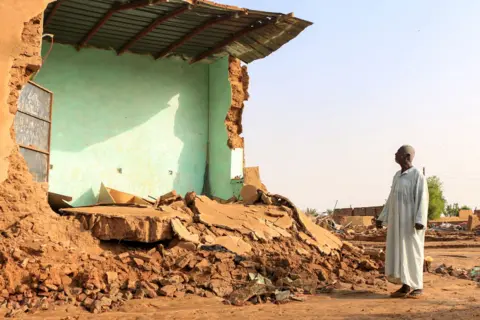
 Hasan Jedi/Getty Images
Hasan Jedi/Getty ImagesClimate change has brought record-breaking heat this year, and with it extreme weather, from hurricanes to month-long droughts.
This year is expected to be the hottest on record, and new research shows that people around the world experienced an additional 41 days of dangerous heat due to climate change.
Researchers from the World Weather Attribution (WWA) group at Imperial College and Climate Central said the study shows “we are living in a dangerous new era”.
From Brazil to Indonesia we take a look back at the climate events that affected the lives of billions in 2024.
Billions suffer under heatwave
This was a year of heat – temperature records were broken on land and in the sea multiple times.
In April dozens of countries, from Lebanon in the west to Cambodia in the east, suffered a prolonged heatwave, bringing the risk of dehydration and heat stroke.
But Julie Arrighi, director of programmes at the Red Cross Red Crescent Climate Centre, said that the impacts are not felt equally.
“Young people and those over 65 particularly those with pre-existing health conditions [are at risk] – they are physiologically less able to cope with extreme heat,” she said.
She said people in conflict settings also suffered disproportionately because of their housing situations, including living in temporary shelters, which can magnify heat, or a disrupted water system.
Research has shown that populations over time can adjust to higher temperatures, but even taking this into account scientists at WWA and Climate Central estimate in 2024 the world’s populations experienced 41 additional days of dangerous heat – compared to a world without climate change.
Dr Friederike Otto, lead of WWA and Senior Lecturer in Climate Science at Imperial College London, said: “The impacts of fossil fuel warming have never been clearer or more devastating than in 2024.
“We are living in a dangerous new era – extreme weather caused unrelenting suffering.”

 Niharika Kulkarni/AFP
Niharika Kulkarni/AFPLifeblood of the Amazon dries up
A regional heatwave around the Amazon region was made worse by a natural climate phenomenon called El Niño, but the researchers at the WWA and Climate Central said that climate change remained the driving force.
Coupled with higher temperatures, rainfall was also reduced across part of South America. Officials in Colombia reported that levels in the Amazon river were reduced by 90% severely affecting power supply, crop yield and leading to wildfires.
Nearly half a million children are thought to have been affected as schools in Brazil and Colombia were closed due to a lack of drinking water, according to Unicef.
The Amazon river is also an important lifeline for the rainforest of the same name – which provides support to thousands of species and supports the world’s efforts to tackle climate change.
“We fear [climate change ] might push the forest irreversibly to a drier state, leading to a reduction of moisture flow and carbon sink, as well as loss of biodiversity,” said Dr Regina Rodrigues, professor of Physical Oceanography and Climate at Federal University of Santa Catarina in Brazil.
“All these critical processes are essential not only locally and regionally but also globally in order to maintain life as we know it,” she said.

 Luis Acosta/AFP
Luis Acosta/AFPPhilippines: an unprecedented Typhoon season
While some suffer from a lack of rain, others got too much of it.
The Philippines experienced a record-breaking six typhoons in just 30 days across October and November – this came after six months of storms. The country is one of the most vulnerable to these tropical storms because of its location close to warm ocean waters.
Landslides and floods triggered by the storms this season killed more than 1,200 people across Southeast Asia.
There is currently no evidence that climate change is increasing the number of typhoons, hurricanes or cyclones (the same phenomenon but named differently across the world), although research suggests it may be increasing their intensity.
But an assessment of the season by WWA scientists concluded the record ocean temperatures that occurred in 2024 were “conducive” to the formation of such storms, and those temperatures have been enhanced by climate change.
Dr Zach Zobel, associate scientist at the Woodwell Climate Research Centre, who was not involved in the study, supported the WWA approach but added: “[This season] didn’t tell us anything we didn’t already know was coming in a 1.3-1.5C [warmer] world.
“Scientists have been warning about these extreme events becoming more frequent for years if not decades,” he said.

 Ezra Acayan/Getty Images
Ezra Acayan/Getty ImagesOcean temperatures fuel an early Hurricane
Even the richest nations were not able to fully protect themselves from extreme weather this year. The US experienced two back-to-back hurricanes – first Hurricane Helene and then Hurricane Milton – which left more than 260 dead and $115bn (£92bn) worth of damage, according to research from Christian Aid.
Scientists had predicted an “extraordinary” season because of the elevated ocean temperatures in the Atlantic, which fuel hurricanes.
But while Hurricane Beryl was the Atlantic’s earliest category five hurricane on record on 2 July, there was a lull in the middle of the season before Hurricane Helene hit.
Dr Otto told the BBC that typically large storms can take heat out of the ocean preventing new hurricanes forming for some time, but qualitative evidence suggests “because the whole upper ocean was extremely hot this effect didn’t happen.”
She added the WWA is looking to undertake further analysis on this in the future.

 Chandan Khanna/AFP
Chandan Khanna/AFPExtreme rains in Nigeria, Chad, Sudan
Flooding in Sudan and Nigeria in August and September showed that extreme weather can be exacerbated by poorly maintained infrastructure.
Heavy rains starting in July brought extensive flooding which led to several dam collapses killing dozens of people and forcing thousands from their homes.

 AFP
AFPThe report from WWA and Climate Central estimates these heavy rainfall episodes have become common events due to human-caused warming, and are expected to occur on average every three to 10 years.
Julie Arrighi from the Red Cross Red Crescent Climate Centre, said: “Our studies continue to show the need to enhance preparedness for extreme weather to reduce loss of life and damages.
“We are not well prepared for life at 1.3-1.5°C of warming.”
Article by:Source –










